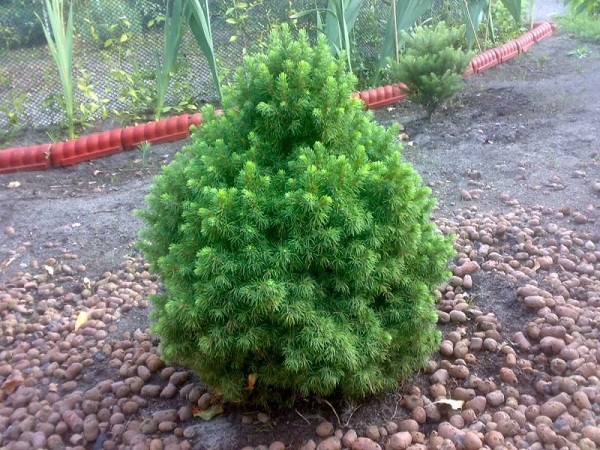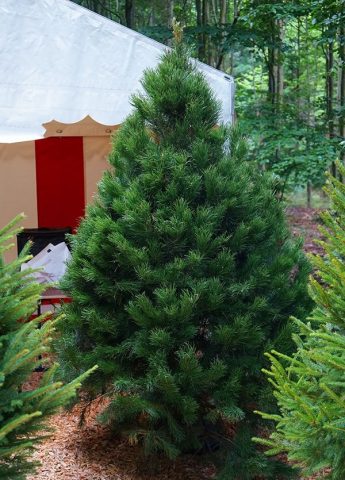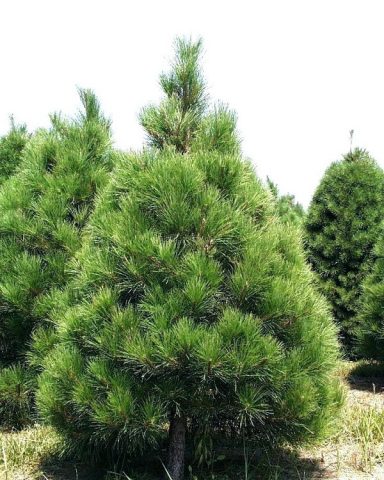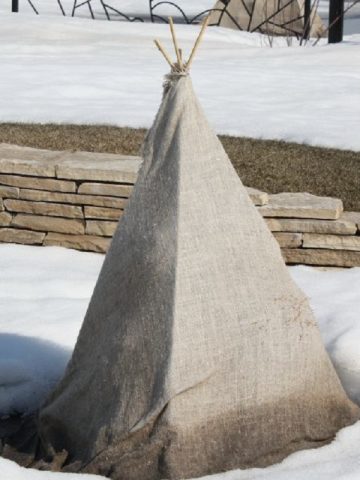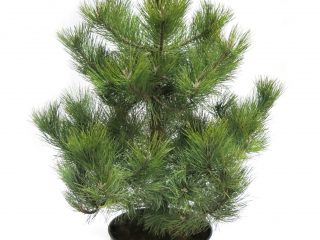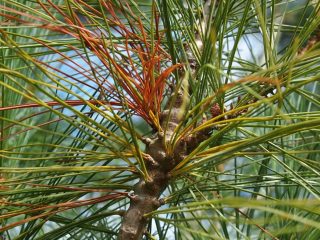Content
Canadian pine or Tsuga is a rare species of ornamental spruce. Lush spruce of the correct shape fits compactly into the landscape of style gardens. The variety is actively gaining popularity among modern summer residents who strive to live away from the city, but in comfort. Due to its simplicity in care, decorative varieties of Canadian pine can be found in urban landscapes.
Description of Canadian pine
The tree has a beautiful appearance, the splendor is given by slightly curved branches directed upwards. Canadian pine grows up to 50-75 m. The shape of the crown is a regular cone with a rounded top. The root system grows in the upper 25-centimeter soil layer, so the young spruce needs to be propped up, protected from drafts and strong winds. A newly planted tree grows 3-4 cm per year. The life cycle lasts from 100 to 500 years under comfortable growing conditions. In the first 10 years, there is an accelerated formation of the crown and growth of the spruce.
The crown of a wild plant is more decorative, but has an average density with branches directed downward. The needles are prickly, have a green tint with a bluish tint. After 10-20 years, light brown cones appear on each branch. The shape of the fruit is round, slightly elongated, without notches and thorns. An adult tree loves abundant watering, grows well in the shade, tolerates severe frosts up to -50 ° C. Basically, pine grows in Canada, although after the introduction to the Russian Federation, the spruce took root only in the northern and central regions of the country.
Decorative varieties of spruce grow up to 1-2.5 m. The needles are only bright green and bluish. At the ends of young branches, protective caps grow, which fall off after the crown has completely grown. There is a round, spherical and conical shape of the tree. The crown of a young pine must be formed through pruning. Throughout the pine tree after 3-4 years of growth, cones of 5-7 cm appear. The root system is flexible, goes underground by 40-50 cm. The thickening of the plant is strong, therefore, the effect of compact splendor is created.
Planting and caring for Canadian pine
You can choose the time to plant Canadian needles in any season. Spruce grows favorably on fertilized or low acid soils. There should be an artificial or natural reservoir near the tree. If there is none, then an automatic irrigation system is used for frequent watering.
Seedling and planting plot preparation
The landing site is chosen with extensive shade or partial shade. In a dark area, the crown diameter grows to 3 m. Favorable soil for growing Canadian pine is loam mixed with black soil. The planting pit is prepared in the fall. The earth is dug up with a full bayonet shovel. Compost with rubble is poured at the bottom, which is dug up before planting.
You can try to grow the plant at home, but you rarely get quality seeds. For planting, a young pine tree 1-2 years old is purchased. High quality seedlings have no damage or rust on the needles and trunk. The soil at the base of the roots should not have a white coating, which indicates insufficient watering and the presence of fungal diseases.
A week before planting, the pine is tempered by temperature changes: it is placed in a dark and cold place for several hours, then kept in a warm and well-lit room for 5-7 hours. The seedling is sprayed with water or watered for 3-4 days in a row with a diluted solution of growth stimulants. Before planting, the roots can be cleared of soil or transplanted together with the primary soil.
Landing rules
Compliance with the recommendations for planting gives a guarantee of good rooting of the root system. Planting rules are simple and standard for any type of pine:
- the drainage layer of the soil should be loose, the thickness of the soil should be 30-40 cm;
- soil mixed with fertilizers is poured onto the drainage;
- the root system must be examined for damage;
- only young and strong seedlings are used for planting;
- the favorable season for disembarkation is March or mid-April, when there is a constant above zero temperature.
At the time of planting, the pine is watered abundantly so that the soil softens. The planting pit should have the following parameters: depth - 60 cm, width 50 cm. The dug soil is mixed with compost or superphosphates. Having distributed the roots over the fertilized soil, the trunk is covered with the remaining soil until the first shoots. A watering irrigation ditch is formed around the needles, then watered: 2-3 liters per seedling. If necessary, the soil is compacted and filled up.
Watering and feeding
The watering rate depends on the life span of the pine. Young plants are watered once a week for 5-10 liters in the first year of growth. In the second year, the number of waterings is reduced to 1-2 times a month, but the volume is increased to 20-30 liters. In the hot season, young Canadian needles are watered at dawn or after dusk so that the moisture does not quickly evaporate. After acid rain, it is recommended to spray with a strong stream of water, so the needles will not turn yellow. The crown of an ornamental plant is sprayed with water every day.
Top dressing is applied to the upper layers of the soil by watering or loosening the soil at the roots. Canadian spruce is fed at the time of planting, then annually in the spring and fall seasons. Fertilizer in granules is scattered around the trunk in a small amount, then watered abundantly. Liquid top dressing is diluted in water, added to the soil with each watering. Mineral fertilizers are applied in spring and autumn before preparing the pine for winter.
Mulching and loosening
In the presence of an imbalance in the air environment of the upper soil layer, pine is mulched within the diameter of root growth. For mulch, hay, peat, last year's needles, sawdust of small or large shavings are used, a natural material that will prevent overfilling of the soil and provide a long-term greenhouse effect for the roots. Canadian spruce is protected by mulching from the appearance of a large amount weeds... The layer of mulch with the age of the pine is increased, changed every season so that fungal diseases do not have time to develop.
Loosening is carried out weekly, but if there is free time, before each watering. They work with a garden rake or a hoe. Weeds grow quickly on refined soil, so with dense thickets, pine can stop growing due to stagnant moisture. The trunk circle should be clean of weeds and fallen needles. When loosening the soil, tools should not be buried more than 3-5 cm, then the plant is mulched or watered.
Pruning
Canadian pine is one of the conifer varieties that requires pruning and crown formation as they grow. Under the influence of shadows or nearby fences, the shape of the tree grows asymmetrically. For pruning, use garden shears, secateurs. The protruding branches are cut to the main contour, and this aligns the contour of the tree. In the spring, fall, and before winterization, Canadian pine is sanitary pruned.Tools are disinfected in a diluted manganese solution if several spruces are processed.
Preparing for winter
With the onset of the first frosts, Canadian pine is mulched with a fresh layer of hay, sawdust or peat. In windy regions, the trunk of the needles is additionally covered with juniper or roofing material. Young seedlings are wrapped in burlap. The trunk, regardless of the age of the tree, is whitewashed to the first branches. Copper sulfate is added to the lime for additional protection from insects. In the spring, the shelter is not removed until the complete absence of frost or severe night frosts.
Reproduction
For the cultivation of Canadian pine, several purchased seedlings of different ages are used. For 3 years of planting, the spruce grows single side shoots, which are cut by a third and planted in a pot. For branching, pinch the top, water the needles abundantly. An increase of 1-2 cm and the appearance of green shoots signals the favorable development and rooting of young Canadian pine.
Some gardeners propagate spruce by seed. Planting time is April or October. The planting material is planted in moist soil, covered with a film to create a greenhouse effect, 2-3 punctures are made. At the first shoots, the seedlings begin to actively water. The seedlings are kept in a shade or dark place until the Canadian pine reaches 10-15 cm in height.
Diseases and pests of the Canadian pine
The causative agents of fungal diseases can be a lack of moisture or improper mulching, due to which root rot develops. From a lack of water, the needles begin to turn yellow and fall off. Also, Canadian pine can get sick with rust, shute or russeting. Spruce is protected from fungal parasites by spraying with chemicals. With careful sanitary pruning, removal of fallen needles, and seasonal replacement of mulch, the pine tree will not hurt for a long time.
Conclusion
Canadian pine is a noble coniferous tree that will decorate and emphasize the wealth of the owner of the garden. Spruce fits well into classic landscape styles. Following the planting rules and recommendations for the care of Canadian spruce, you can not worry about the health of the tree and enjoy the accelerated growth of the pine.
